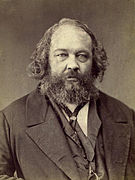Confession (Bakunin)
Background and contents
The Confession accounts for Bakunin's political activities throughout the 1840s, from his original departure from Russia to Berlin in 1840 through his arrest in 1849. The work is neither a capitulation nor an act of defiance, but a combination. Bakunin told Alexander Herzen it was a combination of fancy and truth.[4]
Publication
Nicholas I read the Confession carefully, marking the text with marginalia and sharing it with his son, the
Its full publication in 1921 was controversial, as some read Bakunin as genuflecting for clemency while others defended his criticism of Russian bureaucracy and silence about co-conspirators.[4] Originally written in Russian, the Confession has since been published in Czech, French, German, Italian, and Polish, and only received its first English-language publication in its 1977 translation by Robert C. Howes, published by Cornell University Press along with the emperor's annotations.[5]
Legacy
Historian of anarchism Paul Avrich wrote of the importance of Bakunin's Confession as both a psychological and historial document, showing the roots of Bakunin's pan-Slavicism, antipathy for parliamentary government, plans for a revolutionary society, and mental state as a prisoner. Avrich said the Confession is among Bakunin's most interesting writings[4] highlighting both his personality and an insider's account of the revolutionary 1840s. Avrich added that the author's tone of contrition was a "necessary expedient if he was ever to regain his freedom".[5]
Max Nettlau and Vera Figner both wrote responses to the Confession.[5]
References
- ^ Shatz 2003, p. 35.
- ^ Shatz 2003, p. 36.
- ^ Shatz 2003, p. 37.
- ^ a b c d e Avrich 1978, p. 125.
- ^ a b c Avrich 1978, p. 126.
Bibliography
- JSTOR 2494915.
- Banerjee, Maria (1978). "Review of The 'Confession' of Mikhail Bakunin". Russian History. 5 (2): 227–229. JSTOR 24649602.
- Giffin, Frederick C. (1978). "Review of The Confession of Mikhail Bakunin". The Western Political Quarterly. 31 (2): 307–308. JSTOR 447834.
- Kelly, Aileen (1979). "Review of The Confession of Mikhail Bakunin". JSTOR 4207780.
- Miller, Martin A. (1978). "Review of The Confession of Mikhail Bakunin". JSTOR 1866047.
- Sée, Henri (1932). "Review of Method in social science; a case book; Études socialistes. I: 1888-1897; Socialismes français : du socialisme utopique à la démocratie industrielle; Institutes de science économique. Tome II : Les bases du système économique; Confession, 1857; Das Kapital. Kritik der politischen Œconomie. Ungekürste Ausgabe nach der zweiten Auflage von 1872". Revue Historique (in French). 170 (1): 135–139. JSTOR 40944901.
- Gale OOJNKW999627593.
- "The Confession Of Mikhail Bakunin". CHOICE: Current Reviews for Academic Libraries. October 1977. p. 1113. Gale A31333411.
- "The Confession Of Mikhail Bakunin". Gale A31333410.
- "The Confession Of Mikhail Bakunin". Gale A31333413.
- https://books.google.com/books?id=2ob3KKRKt7wC&pg=PA236


